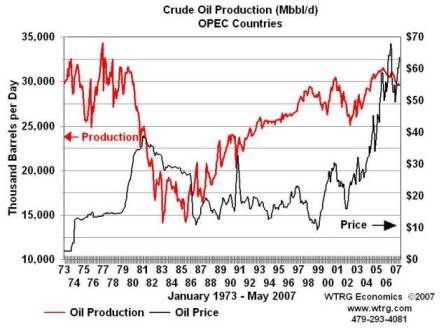(an interoffice email)
Yes, and he reaffirmed that he’s using the futures prices to predict where prices are going. He pointed to crude being at $95 in the back months and stated that translates to a forecast for prices to come down from current levels.
Also indicated the lower dollar is useful for bringing down the trade deficit. This ‘works’ for as long as US labor costs are ‘well anchored’. Congress didn’t grasp this part, as it no doubt would have evoked quite an outcry if they had understood it.
Bernanke plainly stated he considered export growth a desired outcome versus domestic consumption.
Initial claims telling today. Other numbers point to surprises on the upside. This could be partially tempered by Q4 GDP being revised up.
FF futures already discounting cuts to below 2% over the next six months.
While crude inventories are up, markets are saying it’s ‘desired’ inventory as the term structure is still backwardated and WTI is still higher than Brent.
On Wed, Feb 27, 2008 at 12:32 PM, Karim wrote:
All you need to know about BB’s testimony courtesy of the Xinhua news agency:
WASHINGTON, Feb 27, 2008 (Xinhua via COMTEX) — Federal Reserve Chairman Ben
Bernanke told Congress on Wednesday the central bank will again lower interest
rates to boost U.S. economy.
ÂÂÂ
Other highlights:
ÂÂÂ
Commenting on new Fed forecasts from last week:
The risks to this outlook remain to the downside. The risks include the possibilities that the housing market or labor market may deteriorate more than is currently anticipated and that credit conditions may tighten substantially further.
ÂÂÂ
… financial markets continue to be under considerable stress
ÂÂÂ
Important comment on the time frame over which policy should aim to attain objective inflation rates
The inflation projections submitted by FOMC participants for 2010–which ranged from 1.5 percent to 2.0 percent for overall PCE inflation–were importantly influenced by participants’ judgments about the measured rates of inflation consistent with the Federal Reserve’s dual mandate and about the time frame over which policy should aim to attain those rates.
ÂÂÂ
Concluding comments highlight downside risks to growth and inflation pressures but when addressing ACTION, only mentions supporting growth and providing insurance against downside risks.
A critical task for the Federal Reserve over the course of this year will be to assess whether the stance of monetary policy is properly calibrated to foster our mandated objectives of maximum employment and price stability in an environment of downside risks to growth, stressed financial conditions, and inflation pressures. In particular, the FOMC will need to judge whether the policy actions taken thus far are having their intended effects. Monetary policy works with a lag. Therefore, our policy stance must be determined in light of the medium-term forecast for real activity and inflation as well as the risks to that forecast. Although the FOMC participants’ economic projections envision an improving economic picture, it is important to recognize that downside risks to growth remain. The FOMC will be carefully evaluating incoming information bearing on the economic outlook and will act in a timely manner as needed to support growth and to provide adequate insurance against downside risks.
ÂÂÂ
Data-wise, more of the same:
- Durable goods orders down 5.3% after 4.4% rise last month. Core component down 1.4% after 5.2% rise. Capex too small a part of economy and potential rates of change too little to have much bearing on end growth at this stage.
- New home sales down another 2.8% in January and mths supply makes a new high, rising from 9.5 to 9.9; Y/Y median price drops to -15.1% from -7.8%

